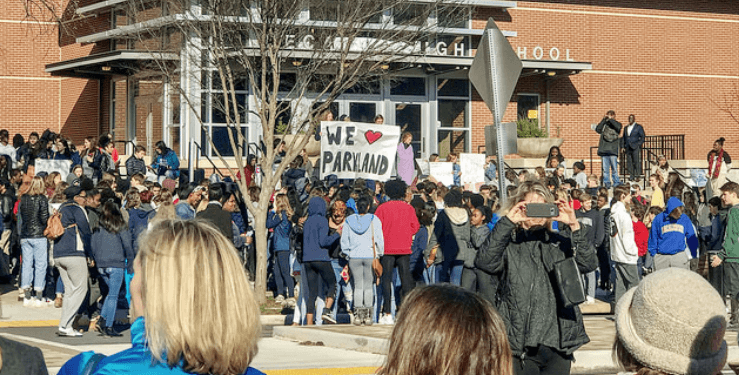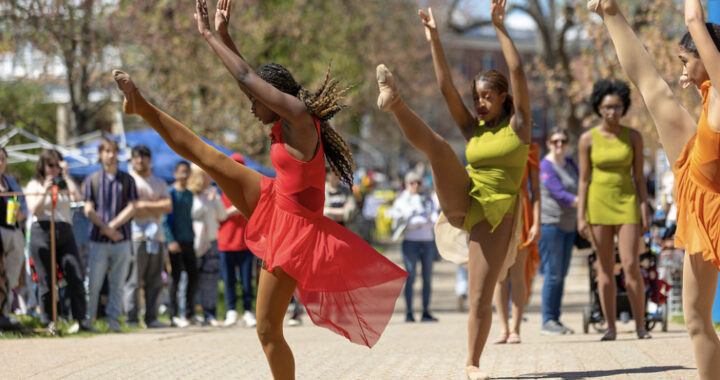UMW participates in National School Walkout
5 min read
Creative Commons
By MEAGHAN MCINTYRE
News Editor
17 minutes for 17 lives.
On Wednesday, March 14 at 10 a.m., across various time zones, students of all ages walked out of classes to show support and solidarity for the victims of the Parkland, Florida, Marjory Stoneman Douglas High school shooting that took place exactly one month prior. The walkouts were also a symbolic way to call for change in gun legislation.
While the core of the walkout originated and took place in the United States, schools in numerous international locations also participated in the walkouts. Ireland, Mexico, Germany and other countries were all involved in the protest.
The demonstration was organized by the Women’s March Youth EMPOWER organization. According to their website, the National School Walkout was planned with specific goals in mind.
“Students and allies are organizing a National School Walkout to demand Congress pass legislation to keep us safe from gun violence at our schools, on our streets and in our homes and places of worship,” said a statement on the official women’s march website. “We view this work as part of an ongoing and decades-long movement for gun violence prevention, in honor of all victims of gun violence ㅡ from James Brady to Trayvon Martin to the 17 people killed in Parkland.”
Around 3616 walkouts were registered as having taken place as a part of the National School Walkout.
Across the country school administrations responded differently to the planned walkouts. Some schools gave pushback and forbid students from leaving. Students were warned that they would be suspended or otherwise punished for participating. Other administrations were more open to, and even encouraging of, student participation in the walkout.
Though some students were unaware of Mary Washington’s participation in the event, professors were encouraged to allow students to participate if they wished to.
On the evening of Tuesday, March 13, Interim Dean of the College of Arts and Sciences (CAS) Dr. Keith Mellinger emailed the CAS faculty to inform them of the planned walkout and to encourage them to be “appropriately supportive” of the students who wish to participate.
Both students and faculty chose to participate in the walkouts. Faculty who walked out alongside students were conscious of being supportive of any decision their students made.
“I have personal opinions about gun violence and what we should do about it, but as a faculty member I did not want to make it a part of the class that was meeting during the walkout,” said professor, Zach Whalen.
Prior to the walkout, Whalen presented his students with two options.
“What I did was say what the class discussion topic for the day was, and told them that if they wanted to start talking they could,” said Whalen. “I also told them that there was the walkout going on, and that I planned to walkout, and they were all free to join.”
While the National School Walkout was publicized, some Mary Washington students did not know the university was taking part in the walkout until right as it was beginning or even after it took place.
Going into her 10 a.m. class, sophomore english major Caleigh Pope was unaware of the walkout but was glad to have the opportunity to participate.
“[My participation] wasn’t planned, but it’s important to stand with the students who are making a difference and trying to make a change,” said Pope.
While some had known about the demonstration going into the day, many students expressed a wish that the walkout had been better publicized among the student body so they would have been made aware that it was taking place.
“I think the walkout was an important way for the students to show their support for the families of the victims of the Florida shooting, and to express their discontent with the current state of gun laws,” said sophomore environmental science major Mary Hoffman. “I wish it had been better publicized, because this is a really important issue and I would have participated without hesitation had I known about it.”
Beyond respecting the goals of the demonstration to call for change in gun legislation and to honor the lives of the victims of gun violence, students and faculty had their own reasons for participating in the walkout.
“For me personally, I think it is really important that people in higher ed show their support for movements in K-12,” said UMW class of 2015 alum, and Division of Teaching and Learning Technologies (DTLT) employee, Jessica Reingold. “I feel like a lot of the time movements that happen in K-12 get lost in higher ed. And it is important that they do not because these are the students that will be coming here next.”
“I wanted to symbolically support the movement,” said Whalen.
Even though she was unable to participate in the walkout, sophomore psychology major Miranda Batte-Futrell was able to discuss the empowering feeling that comes with participating in a walkout for a good cause.
“As someone who has previously participated in a walkout, I know how empowering and influential they are, ever if only in the smallest way,” said Batte-Futrell. “Walkouts give individuals a collective voice that projects concerns and stances to the government, who then might have to take some type of action or face further backlash.”
While some students supported the goals of the walkout, they felt they create more of a statement on a high school level than they do on a college campus.
“For high schoolers, I feel walking out is so much more impactful, because this movement is focused on them and their school environment is much more strict regarding attendance,” said senior Es Hethcox. “The high school’s walking out of school are the movement, and the nation’s eyes are on them. We college students are supporters, but the nation is not watching us in this movement.”
Though the focus of the activism appears to be primarily on high schoolers who are speaking out, many feel it is important to remember that these acts of violence are not solely limited to taking place at one educational level.
“These acts of violence are not limited to K-12,” said Reingold. “They have happened on higher ed campuses. They need to be something we don’t forget about.”
Walkouts are one form of civil protest; another popular demonstration method is marches. Alongside the National Walkout Day, the March For Our Lives will be held on March 24 in Washington D.C. Survivors of the Marjory Stoneman Douglas High School shooting are leading the organization of this rally.
Both for the march, and the walkouts, social media has played a role in spreading the word about them. Celebrities such as Zendaya, Lin-Manuel Miranda, Kendall Jenner, Jon Bon Jovi, Ellen DeGeneres, Katy Perry, and many more took to social media to express their support for the students who participated in the walkouts. A video posted by The Views twitter account showed Whoopi Goldberg with a group of students marching down the streets of New York City.
As the call for change regarding gun policy continues, members of the UMW community feel the importance to take an active stance in the movement.
“The K-12 kids are the future,” said Reingold. “If we are not showing our support for the potential leaders of the future, then we are being passive and that is not good.”











